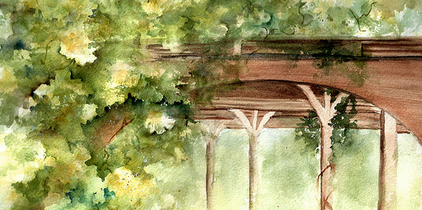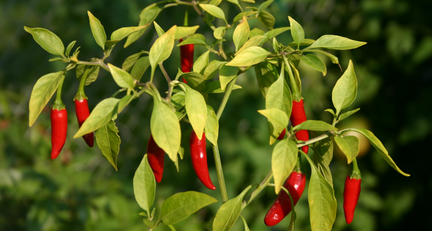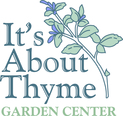In honor of Herb of the Year pepper (capsicum), and this Satur-
day's International Herb Day, we are proud to offer an advance
chapter from Mick Vann's upcoming e-book 'Old Mex, New Mex
and Tex Med: Favorite Recipes of regional Mexico, Texas and
New Mexico.' Available this summer.
From the time of the first arrival of chile peppers to the Old
World in the late 1400s science has been fascinated with the basis
behind the burn. Yet only in the 20th century have scientists been
able to really interpret the chemistry involved and give the chile-
heads of the world some solid science to explain their burning
and craving.
Capsaicin, the organic compound which creates the heat of the
chile pod, is produced by microscopic glands found at the junc-
tion of the placenta and the chile’s interior wall. This explains
why one can lower the pungency of a chile by removing the ribs
(membranes) and seeds, because it is this area that holds the
highest concentration of capsaicin.
Pure capsaicin is a dark red, solid, odorless organic compound
which, when crystallized, forms long, hexagonal, needle-like,
evil looking crystals. From an elemental point of view, capsai-
cin is known as 8-Methyl-N-vanillyn-6-nonenamide, and yes,
vanilla is a chemical first cousin of capsaicin, which might seem
strange flavor-wise.
It is insoluble in water, so no matter how much water you drink
to try to quell the heat, it will only bloat you and tend to make
you pee. Capsaicin is soluble in vegetable and mineral oils,
meaning that the most practical and effective way to cool the
burn is with dairy fat, such as that found in milk, yogurt, and ice
cream.
Dairy products also contain casein, a lipophilic (fat-loving) sub-
stance which surrounds and washes away the fatty capsaicin mol-
ecules. Dairy is kryptonite for capsaicin. You could drink vegetable
oil or eat lard but you might want to reserve that for only the most
extreme situations.
It is also soluble in ethyl alcohol, making Everclear an effective
(but highly impractical) means of cooling down those taste buds.
Beer’s ethyl alcohol concentration is too low to be very effective,
so once again we’re back to the bloating and peeing part, while
the mouth still burns.
You can also drink something acidic which will help neutralize
the alkaline capsaicinoids. Perhaps some cold lemonade, a bite
of a lemon or lime slice, cold orange juice, anything with tomatoes,
or drinking milk (which is also acidic) might be beneficial.
__________________________________
Capsaicin melts at 149°F, which means that a warm dish contain-
ing chile will permeate and coat the mouth much faster than, say,
a bowl of cold salsa. It is a surprisingly stable compound, unaff-
ected by heat or cold, and keeps its potency whether it is frozen,
cooked, or desiccated.
It is one of the most pungent compounds known to man, capable
of detection by the human tongue in dilutions of one part per 17
million. A single milligram of pure capsaicin (the equivalent of
about 10 grains of salt) placed on the palm of an ungloved hand
would feel like a burning spike and would blister the skin.
Human nerve cells have receptor proteins for binding with capsai-
cin. When we eat chile and these receptors are stimulated, they
carry a signal from the tongue to the spinal cord and then straight
to the brain.
It is then when we realize that we have eaten something spicy.
At the same time, receptors in the brain are stimulated to release
endorphins, which are natural painkillers we synthesize, promot-
ing a sense of elation and well-being.
Luckily, at the same time, capsaicin causes a long-term desensit-
ization to the pain of the heat. Repeated stimulation of these sen-
sory nerves produces a reduced response curve due to an influx
of calcium ions entering the nerve, which can actually kill nerve
endings over time.
This is a very similar response to that of the addiction of drugs.
In summation, we eat chile › we burn › we feel elated and want
to eat more › we eat more and become desensitized › we are addic-
ted and elated!
A 1980 study proved we are in little danger from “normal” con-
sumption. It determined an average sized person would have to
chug a half gallon of Tabasco sauce in a short period of time to
overdose and become unconscious (a warning perhaps to all of
the frat houses and Japanese game shows out there).
Not to worry though because capsaicin alkaloids are quickly met-
abolized and excreted out of the body in one’s urine within a few
hours after consumption.
Bottom line, science tells us that capsaicin is our friend. Eating
chiles gives us a nice dosage of vitamins A, C, and E (as well
as folic acid and potassium) with little calories or sodium, no
gluten, and zero cholesterol.
It jazzes up our food, cools us off by making us sweat, and makes
us as happy as the most zealot jogger without ever having to leave
our easy chair. As long as we stay away from the pure capsaicin
extracts, all it takes is a little dab of yogurt, ice cream, or milk
to salve the hottest bite, and we’re ready for more.






